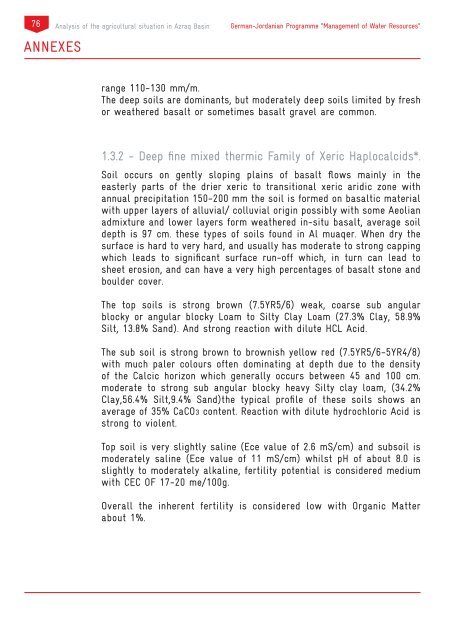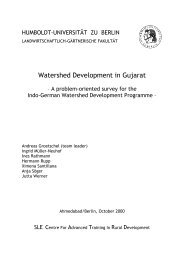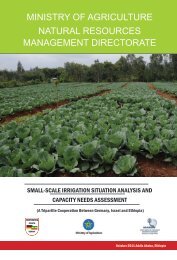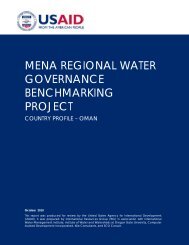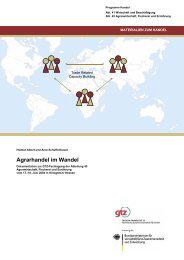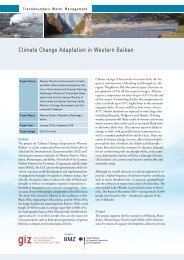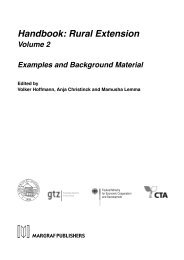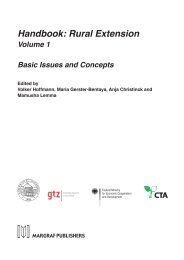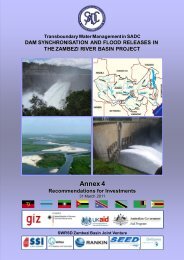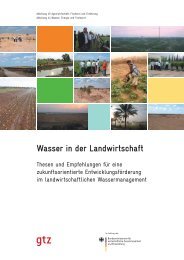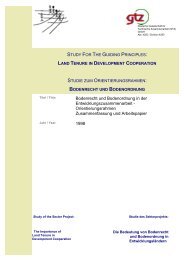Farming in the - WordPress.com
Farming in the - WordPress.com
Farming in the - WordPress.com
Create successful ePaper yourself
Turn your PDF publications into a flip-book with our unique Google optimized e-Paper software.
76<br />
ANNEXES<br />
Analysis of <strong>the</strong> agricultural situation <strong>in</strong> Azraq Bas<strong>in</strong><br />
German-Jordanian Programme “Management of Water Resources”<br />
range 110-130 mm/m.<br />
The deep soils are dom<strong>in</strong>ants, but moderately deep soils limited by fresh<br />
or wea<strong>the</strong>red basalt or sometimes basalt gravel are <strong>com</strong>mon.<br />
1.3.2 - Deep f<strong>in</strong>e mixed <strong>the</strong>rmic Family of Xeric Haplocalcids*.<br />
Soil occurs on gently slop<strong>in</strong>g pla<strong>in</strong>s of basalt flows ma<strong>in</strong>ly <strong>in</strong> <strong>the</strong><br />
easterly parts of <strong>the</strong> drier xeric to transitional xeric aridic zone with<br />
annual precipitation 150-200 mm <strong>the</strong> soil is formed on basaltic material<br />
with upper layers of alluvial/ colluvial orig<strong>in</strong> possibly with some Aeolian<br />
admixture and lower layers form wea<strong>the</strong>red <strong>in</strong>-situ basalt, average soil<br />
depth is 97 cm. <strong>the</strong>se types of soils found <strong>in</strong> Al muaqer. When dry <strong>the</strong><br />
surface is hard to very hard, and usually has moderate to strong capp<strong>in</strong>g<br />
which leads to significant surface run-off which, <strong>in</strong> turn can lead to<br />
sheet erosion, and can have a very high percentages of basalt stone and<br />
boulder cover.<br />
The top soils is strong brown (7.5YR5/6) weak, coarse sub angular<br />
blocky or angular blocky Loam to Silty Clay Loam (27.3% Clay, 58.9%<br />
Silt, 13.8% Sand). And strong reaction with dilute HCL Acid.<br />
The sub soil is strong brown to brownish yellow red (7.5YR5/6-5YR4/8)<br />
with much paler colours often dom<strong>in</strong>at<strong>in</strong>g at depth due to <strong>the</strong> density<br />
of <strong>the</strong> Calcic horizon which generally occurs between 45 and 100 cm.<br />
moderate to strong sub angular blocky heavy Silty clay loam, (34.2%<br />
Clay,56.4% Silt,9.4% Sand)<strong>the</strong> typical profile of <strong>the</strong>se soils shows an<br />
average of 35% CaCO3 content. Reaction with dilute hydrochloric Acid is<br />
strong to violent.<br />
Top soil is very slightly sal<strong>in</strong>e (Ece value of 2.6 mS/cm) and subsoil is<br />
moderately sal<strong>in</strong>e (Ece value of 11 mS/cm) whilst pH of about 8.0 is<br />
slightly to moderately alkal<strong>in</strong>e, fertility potential is considered medium<br />
with CEC OF 17-20 me/100g.<br />
Overall <strong>the</strong> <strong>in</strong>herent fertility is considered low with Organic Matter<br />
about 1%.


